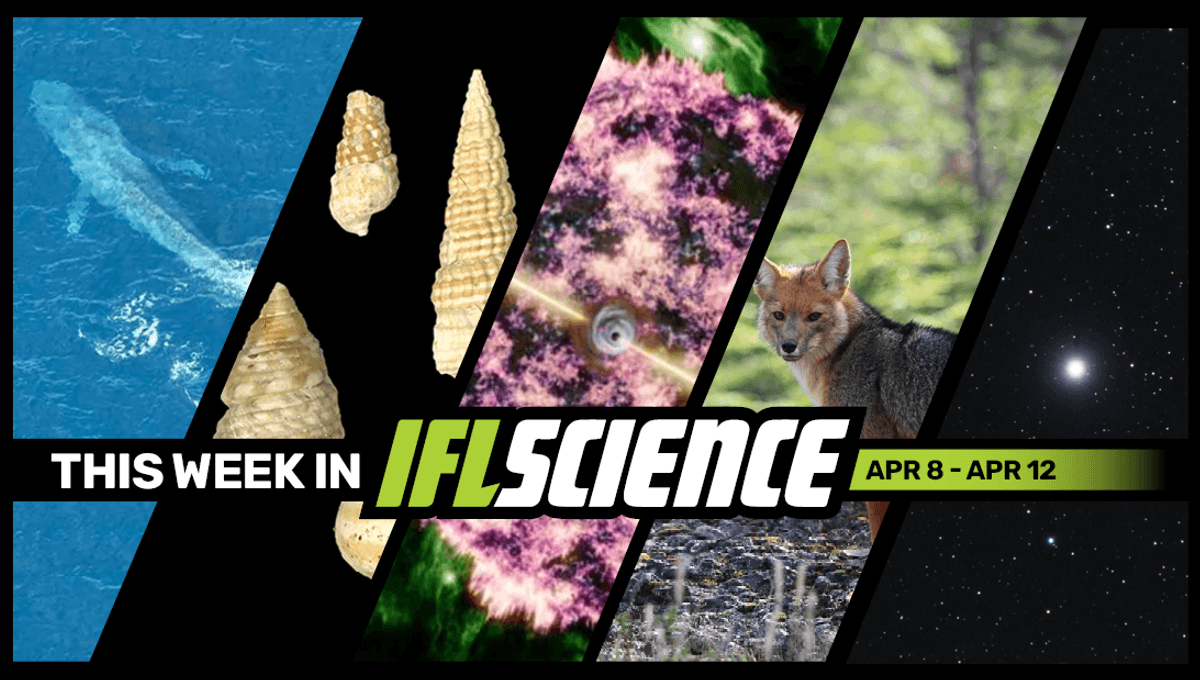
This week, the world’s oldest preserved fossil polyene pigments were found in 12-million-year-old snail shells, long before dogs, foxes may have been humans’ best friend, and we say goodbye to Polaris as we prepare to get a new north star. Finally, we ask what on Earth is a henge?
Subscribe to the IFLScience newsletter for all the biggest science news delivered straight to your inbox every Wednesday and Saturday.
Rare Photos Show Blue Whales Performing The Largest Mating Dance On Earth
Male blue whales have been witnessed battling for the chance to mate with a female off the coast of Australia in arguably the most formidable combat on Earth. When male whales sense a female is fertile, they follow her. The males use their bulk against each other to try and gain an advantage and be her “escort”. Collectively, this is known as a racing group and is very rarely witnessed by humans or caught on camera. Read the full story here
World’s Oldest Preserved Fossil Pigments Found In 12-Million-Year-Old Snail Shells
Colors in the natural world can come in just about every possible shade, from the bright blues of a peacock’s tail feathers to the glow of an animal under ultraviolet light. Now researchers have found some of the earliest traces of the pigments that help produce the pretty colors in snail shells and they are around 12 million years old. Read the full story here
We Now Know What Caused The Brightest Explosion Ever Seen In Space
The gamma-ray burst GRB 221009A, better known as the B.O.A.T (“brightest of all time”), was so far off the charts that we would only expect to see something this bright once every thousand years. Naturally, astronomers expected some phenomenal event to be responsible – but instead, the phenomenon that generated the explosion was unexpected, with few clues as to why it would produce something so dazzling. Read the full story here
Foxes May Have Been Humans’ Best Friend Long Before Dogs
Ancient hunter-gatherers in South America may have kept foxes as pets before domestic dogs arrived on the continent. Evidence for this unexpected alliance comes from a 1,500-year-old burial site in Patagonia, Argentina, where a human skeleton appears to have been buried alongside a fox, suggesting that the pair may have shared a special bond during their lifetimes. Read the full story here
So Long Polaris: The Earth Will Get A New North Star
If you look up into the clear night sky in the Northern Hemisphere, you will see the star Polaris, more commonly known as the North Star. Sitting around 1 degree away from the geographic North Pole, Polaris has been used in navigation (of the Northern hemisphere) for centuries. But it hasn’t always been our North Star and won’t be forever either. Read the full story here
TWIS is published weekly on our Linkedin page, join us there for even more content.
Feature of the week:
What Is A Henge, And Why Were They Built?
If we ask you to imagine a henge, we’d bet your mind instantly goes to the now-iconic Stonehenge in Wiltshire, UK. This prehistoric megalithic structure is, in the minds of many people, the quintessential example of a henge. It’s even in the name, right? Well, not quite. Stonehenge isn’t actually recognized as a true henge, despite giving its name to the classification. This raises a rather obvious question: what on Earth is a henge? Read the full story here
More content:
Have you seen our e-magazine, CURIOUS? Issue 21 April 2024 is out now. Check it out for exclusive interviews, book excerpts, long reads, and more.
PLUS, the entire season 3 of IFLScience’s The Big Questions Podcast is available now.
Source Link: Blue Whales Caught Performing The Largest Mating Dance On Earth In Rare Photos, We Know What Caused The Brightest Explosion Ever Seen In Space, And Much More This Week